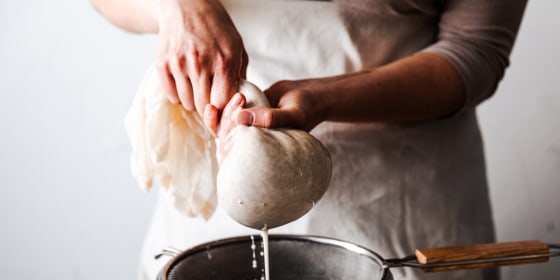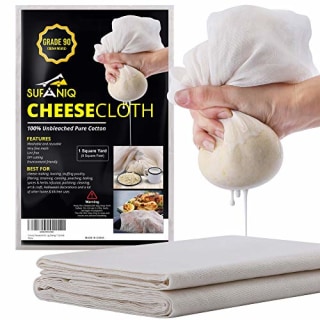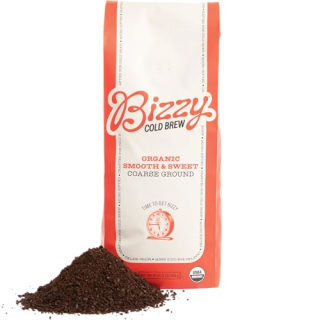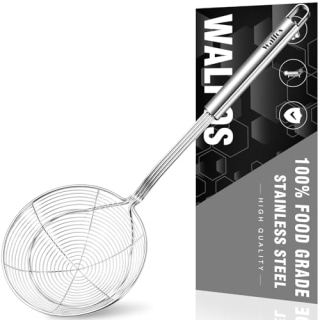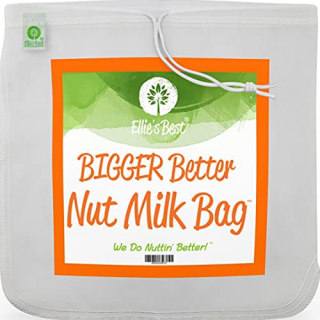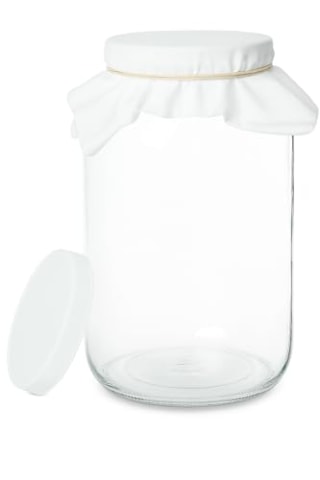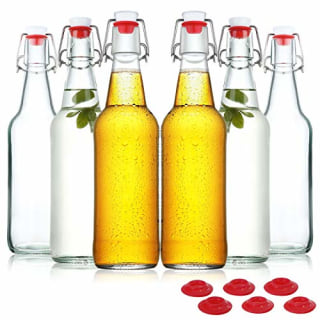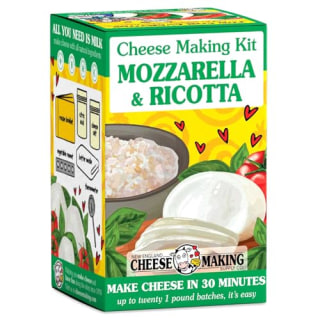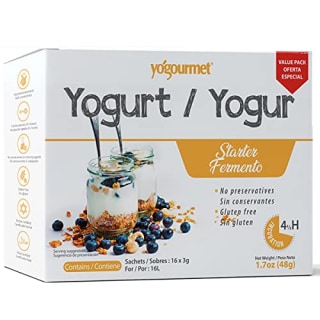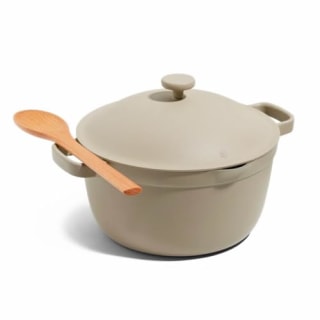I love being in the kitchen experimenting with ingredients and making something new, but even I can admit there are some kitchen tools that aren’t exactly necessities. Some utensils and appliances like air fryers are life-changing for many obvious reasons (yes, I’m talking about French fries).
Other tools, however, can go unnoticed and are severely undervalued, in my experience: Enter the humble yet multifaceted cheesecloth. While it looks like just a cloth, it has just as much versatility as a chef’s knife and you can use them while prepping almost any meal or drink, according to Tiffany Swan, a wellness retreat chef. “Cheesecloth is helpful for straining stocks and broths, alt milks, and of course cheese,” she says. “But it’s also helpful for tying up herbs so you don’t have to fish stems out of your soup, making a big pot of tea, or even making coffee in a pinch.”
SKIP AHEAD What is a cheesecloth? | Other accessories to use alongside a cheesecloth | Why trust NBC Select?
Want more from NBC Select? Sign up for our newsletter, The Selection, and shop smarter.
What is a cheesecloth?
A cheesecloth is a woven cotton cloth with a soft netting texture that chefs use to make cheese by straining excess water through its small holes. Despite its name, you can use a cheesecloth to make a ton of other foods and drinks from scratch too, like non-dairy milk, kombucha, cold brew coffee, broth and stock, latkes and recipes with vegetables that hold a lot of moisture. You can also use it to make liqueurs, like limoncello, during the holidays.
Some chefs also use it when making doughs or ferments to create a barrier of airflow when the dough or ferment is developing,” says Olivia Roszkowski, chef-instructor at the Institute of Culinary Education. You can also use one to make tofu, butter and plant-based cheese from cashews, according to Roszkowski.
Cheesecloths come in different textures and weaves and they’re typically sold as part of a roll (like paper towels), folded together or in the form of a bag or pouch.
Sufaniq Cheesecloth
- Lint free
- Available in different lengths
- Nothing to note at this time
This cheesecloth is made from 100% unbleached cotton and has a muslin weave, which is partially transparent. You’ll get up to 9 square yards worth of cloth, which you can cut and shape into small sheets as needed. I use a very similar option to make ricotta cheese, and it always comes out perfectly with none of the cheese getting through the sheet. Aside from cheese, you can use it to make kombucha, yogurt, milk, fruit juice and to baste a turkey, according to the brand.
Other accessories to use alongside a cheesecloth
Cheese is only one of several things you can make with a cheesecloth. If you plan on making homemade Greek yogurt, tofu, tea, soup, quick breads and nut and oat milks, you’ll want these items, too. All of the product recommendations below are either direct recommendations from NBC Select staff members or have at least a 4-star average.
Pyrex Smart Essentials 3-Pack Mixing Bowl Set
- Dishwasher safe
- Durable tempered glass
- Stackable
- Lids not included
When I tested nut milk bags while making almond milk, I realized how important it is to have a large, wide bowl to strain milk into. While the cheesecloth was necessary for straining milk from the blended almonds, the milk splashed out of it slightly and I had some minor spills on my countertop because I didn’t use a wide-enough bowl. This is why I recommend getting a durable set of glass mixing bowls like these. When I worked in food media, I used Pyrex glass bowls all the time to test out recipes, and they always have the highest quality feel and weight to them, and the same goes for their measuring cups, which I use almost daily.
Bizzy Organic Cold Brew Coffee
- Can brew at room temperature
- Can prepare in French press
- Coarse grind
- Best brewed for 14 to 24 hours
If there’s one thing I’m known for by my colleagues at NBC Select, it’s that I always have a cup of cold brew in hand. While I almost always buy it already prepared, I sometimes make it at home to save money. When doing so, I use a cheesecloth to prepare my cold brew in the same way I do nut milk: After letting water and coffee grounds brew overnight, I strain it through a cheesecloth into a carafe or drink dispenser. This prevents the bitter and gritty grounds sitting at the bottom from ending up in my drink. If you want to try it yourself, these Bizzy Organic cold brew grounds are quite popular — they have a 4.6-star average rating from 14,781 reviews on Amazon. The brand produces them especially for cold brew, and sells various blends including breakfast, dark and bold and espresso. The brand even sifts the coffee grounds through super fine filters to make sure the coffee texture comes out the same each time, according to Bizzy Organic.
Walfos Spider Strainer
- Heat safe up to 600 degrees
- Dishwasher safe
- Reinforced wire handle
- May not fit in a drawer
Malin loves using cheesecloths to make latkes during the holidays to give them the best texture. “After I shred potatoes and onions for latkes, I lay a cheesecloth on my counter, pour the ingredients onto it, wrap them up and squeeze all the liquid I possibly can out over the sink,” she says. “The more liquid I can get out, the crispier my latkes are, and the cheese cloth works so much better than a dish towel.” This stainless steel spider is well suited for frying small foods, especially compared to a spatula, since the end has a curved design, preventing your latkes from sliding back into the oil. Plus, you can also use it for fishing boiled vegetables or pasta from water.
Ellie’s Best Pro Quality Nut Milk Bag
- Dishwasher safe
- Has a drawstring
- Best for making drinks
I used this nut milk bag when I reported on how to make almond milk from scratch, and it worked perfectly. I’ve also used this to squeeze excess liquid out of vegetables like zucchini. Baking recipes, like zucchini bread and carrot cake require you to strain the liquid out of shredded vegetables to prevent bread or cake layers from getting ruined, which is far easier to do with a cheesecloth or a similar reusable strainer. A colander isn’t fine enough and a paper towel will usually break (speaking from experience), so if you enjoy using fresh fruits and vegetables in baked goods, consider this option.
1-Gallon Glass Kombucha Jar
- Good for food storage
- Easy to clean by hand
- Plastic free
- May not fit in every fridge
When brewing tea to make kombucha, a cheesecloth helps the fermentation process move along and produce the scoby, which is the basis for making kombucha — sort of like what a starter is to sourdough bread. You can add freshly brewed tea to this jar along with a portion of pre-made kombucha to create the scoby. Since it’s wide and has a large mouth, you can put your hand in it to thoroughly wash any sediment that might stick to the bottom, too. It has a 4.7-star average rating from 503 reviews on Amazon and you can also use it along with a cheesecloth to make a large batch of loose-leaf teas or juices, like chai or hibiscus.
Glass Bottles for Home Brewing (Case of 6)
- They have an airtight seal
- Removable silicone gasket
- Dishwasher safe
- Hard to clean inside by hand
NBC Select senior manager of community engagement Rosalie Sparaco makes limoncello with her family around the holidays every year and says that using a cheesecloth makes the process extremely easy. “We use a family recipe that involves combining lemon peels, sugar, water and grain alcohol and letting them sit for at least 10 days,” she says. “At the very end, you need to strain the mixture before bottling so none of the bits of pith or peel get into the bottles. We always use cheesecloth at this step because it’s much finer than a regular sieve or colander, so less impurities pass through.” If you’re interested in doing the same, you can use these glass limoncello bottles, which have a 4.7-star average rating from 4,524 reviews on Amazon and come with an attached lid to keep the homemade liqueur fresh. They also have a small mouth to make pouring mess free.
Mozzarella and Ricotta Cheese Making Kit
- Good gift for kids
- Helpful directions
- Best with dairy milk
The first time I made ricotta from scratch I was so surprised by how few ingredients were required. While there are a few ways to make it, at its foundation, you only need a cheesecloth, whole milk, salt and some sort of acid like lemon juice. After the curds start to form, is when it’s time to strain the liquid from them with a cheesecloth or bag. This useful kit has a 4.2-star average rating from 1,390 reviews on Amazon and makes the process simple since it includes a packet of citric acid powder, rennet (an enzyme that gives mozzarella its texture), a thermometer, salt and a sheet of muslin cheesecloth. You can use it to make up to 20 1-pound portions of cheese and prepare 1 in only 30 minutes, according to the brand.
Yogourmet Yogurt Starter
- Good for Bulgarian yogurt
- Gluten free
- Customizable flavor
- Best with dairy milk
Like with a kombucha scoby and sourdough starter, to make yogurt, you’ll need a culture to start the process with. NBC Select editorial director Lauren Swanson loves making yogurt from scratch, especially with the help of a cheesecloth. This kit has a 4.3-star average rating from 2,550 reviews on Amazon and includes 16 3-gram sachets of yogurt starter culture, with each packet making up to 1 liter of yogurt, according to the brand. After letting the yogurt incubate for 4 to 5 hours, you can test it to make sure it’s the right texture. The cheesecloth helps get rid of excess moisture and give it a creamy texture.
Our Place Perfect Pot 5.5-Quart Perfect Pot
- Oven safe
- Available in 2.5 quarts
- Comes with wooden spoon
- Best for home cooks
If you like making homemade chicken broth or stock, you’ll need a large pot, in addition to a cheesecloth. Our Place’s Perfect Pot, which NBC Select reporter and fellow home cook Zoe Malin tested and reviewed, is PFAS free and oven safe up to 450 degrees, according to the brand. When you’re not using it to boil stock, you can also use it to deep fry foods, steam vegetables and braise meat. After simmering your seasonings and alliums, you can strain the liquid through the cheesecloth into a large bowl. Then, divide the stock into individual food containers. Swan also recommends using cheesecloth to strain fresh tomatoes for soup in the summer.
Meet our experts
At NBC Select, we work with experts who have specialized knowledge and authority based on relevant training and/or experience. We also take steps to ensure all expert advice and recommendations are made independently and without undisclosed financial conflicts of interest.
- Tiffany Swan is a chef at a women’s wellness retreat based in Lake Tahoe, California.
- Olivia Roszkowski is a chef-instructor of plant-based cuisine at the Institute of Culinary Education
Why trust NBC Select?
I’m a commerce editor at NBC Select who covers various kitchen and cleaning topics — I’ve reported on recent stories about the best at-home soda makers, portable blenders and pasta makers. I’m also an avid home cook with years of experience in food writing, recipe testing and editing. I spoke to two culinary experts for their guidance and NBC Select editors for their experience using cheesecloth for cooking.
Catch up on NBC Select’s in-depth coverage of tech and tools, wellness and more, and follow us on Facebook, Instagram, Twitter and TikTok to stay up to date.
